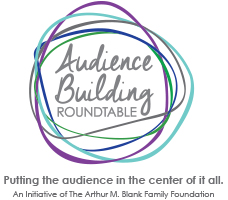By John Bare, Vice President, The Arthur M. Blank Family Foundation
Everybody loves storytelling.
Everybody hates evaluation.
Upon this wisdom, I issue a challenge to members of the Audience Building Roundtable: I want to see you become the best storytellers in Metro Atlanta.
Here’s what you’ll need:
A main character. This is an individual or group setting out on a journey. Some characters meander around before discovering a purpose. Or, as with the Roundtable, it could be a group of colleagues working as a team in pursuit of the holy grail – interested, non-attenders or lapsed patrons. You want us to fall in love with your team.
An inciting incident. This is where your team runs into conflict. Think dragons, zombies and Mr. Potter of Bedford Falls. The incident could occur immediately. A villain could empty the hero’s 401(k) during the opening credits. Or trouble might emerge when we least expect it, just when your team was about to grab hold of the prize.
Resolution. This is where our hero – we really do love your team at this point – either wins the chase, or not. Do you prevail, like Norma Rae? Or do you perish, like Butch and Sundance?
There’s nothing to it. Unlike the waiter at Jerry’s Deli, you don’t have to dream up a screenplay to sell. As a Roundtable member, all you have to do is take note of the daily events in your audience building journey. Then when it comes time to reflect, you will have all of the pieces and parts you need to map out the shape of your story.
Start by designating one or more staffers to keep an Audience Building Journal. By taking 5 or 10 minutes every day to make notes in a journal, you will capture the real-time detail that, upon later retelling, will grab your audiences. Using this approach, your story will be so authentic, your vulnerabilities so real and the surprises so jolting that it won’t matter so much whether you found success or failure in your adventure. If you wait a year and try to reconstruct the past, it won’t be the same. Every tale written with hindsight is slick and every hero too cute by half.
The evaluation field so appreciates the storytelling method that there is a fancy name for a version of this approach, Most Significant Change. The method involves participants, not outside experts, so it increases the capacity of organizations while capturing vivid description of what actually happened, as opposed the sterilized version of events that usually appears in reports to funders.
With every member committed to capturing its own stories, the Roundtable will need to create a leadership group to be sure that every gathering sets aside a few minutes to share and discuss the stories. Every story captured, in written form or digital, should be organized in a central database. This will allow Roundtable members and funders to revisit the pool of stories to classify which stories yielded the most significant lessons.
Stories found to be most significant can be included in the Roundtable’s sacred bundle, the collection of totems used to establish and preserve a shared culture across generations. In this way, storytelling serves both an evaluation function and an organizational development function.
Most important, storytelling requires a commitment from you, not an itinerant consultant, to lead the work.
This is fitting. After all, we are all the heroes of our own stories.
Keywords: Storytelling, capturing stories, Most Significant Change
